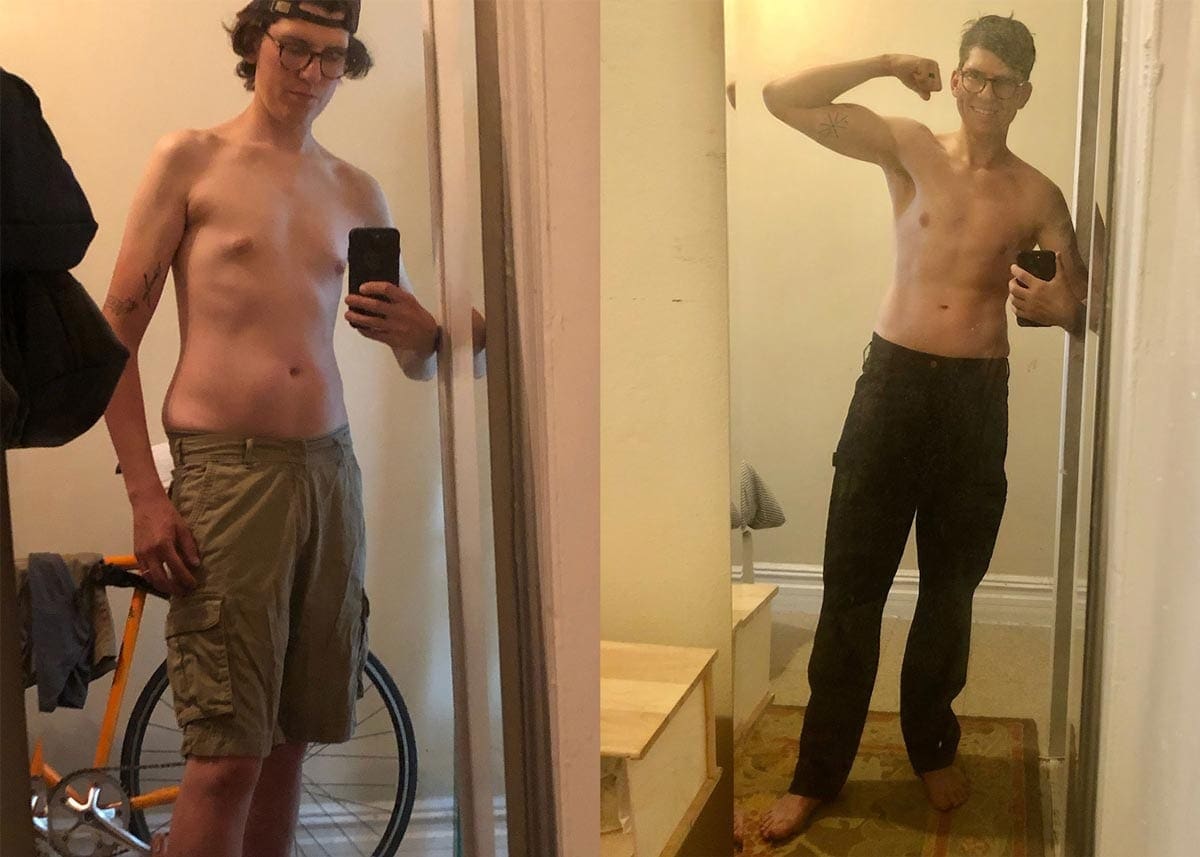“This Might Be Me” – JT’s story
Written By: Chelsea Castonguay in collaboration with JT and his wife.
JT is a 33 year old man living with Klinefelter Syndrome in a large US city. He’s one of several men who have volunteered to share their story with the team at Living With XXY, in the hopes of raising awareness for what’s often a misunderstood and underfunded genetic condition that is actually fairly common. According to the National Institutes of Health (NIH), it’s estimated that 1 in 650 male births carries the extra X chromosome, known as Klinefelter Syndrome. “It is among the most common sex chromosome disorders, which are conditions caused by changes in the number of sex chromosomes.” (NIH) This is JT’s story about his childhood, education, diagnosis, and life with Klinefelter Syndrome. To maintain JT’s privacy, as well as that of his family, we’ll be using his initials and redacting personal information.
Childhood
 Born in South Dakota, as a young child JT moved with his parents and older sister to a small town in southern Minnesota. Throughout his youth, JT’s main health concern was a diagnosis of Wolff-Parkinson-White (WPW) syndrome, a rare condition stemming from an extra electrical pathway in the heart, which causes periodic rapid heartbeats. In some cases it can lead to more serious conditions later in life. As a result, JT spent much of his pre and middle teens being shuttled to doctor’s appointments by his mother. Though his health was scrutinized, the focus was pointed at his heart alone, and any diagnosis of Klinefelter Syndrome or how it might be affecting him was far away in his personal timeline.
Born in South Dakota, as a young child JT moved with his parents and older sister to a small town in southern Minnesota. Throughout his youth, JT’s main health concern was a diagnosis of Wolff-Parkinson-White (WPW) syndrome, a rare condition stemming from an extra electrical pathway in the heart, which causes periodic rapid heartbeats. In some cases it can lead to more serious conditions later in life. As a result, JT spent much of his pre and middle teens being shuttled to doctor’s appointments by his mother. Though his health was scrutinized, the focus was pointed at his heart alone, and any diagnosis of Klinefelter Syndrome or how it might be affecting him was far away in his personal timeline.
JT also had dental issues in his youth, stating he “struggled with bad teeth,” and needed “a lot of dental work.” In retrospect, JT wonders if this correlates to the bone density issues men with Klinefelter Syndrome can experience.
Middle school was a difficult time for JT, as it is for a lot of kids. In JT’s case, his peers’ awareness of their changing bodies led to them noticing and ridiculing his slightly larger nipples (as related to Klinefelter Syndrome). Also, despite having a keen interest and affinity for math, JT’s parents weren’t able to secure him a place in his school’s advanced mathematics classes, which he described as “frustrating.” At this point, JT’s talents were yet to be realized or acknowledged, though this would later change. An interest in computer sciences sustained JT, but English classes, and most aspects of writing and grammar in general, were areas he majorly struggled to grasp. Having completed a graduate degree, JT has made tremendous progress in these areas with sustained work as an adult, regardless of the struggle writing will always pose for him.
High school – “I was looking for the doors that were open and I was walking through them.”
JT’s high school experience began as an attempt to keep up with his older sister, who he described as a “sports star.” In an effort to please his sports-focused father, JT threw himself into athletics, even though it “really wasn’t something I wanted to do.” JT first attempted football, and during this time his father developed a travelling basketball team for which he recruited the area’s top players. While JT was placed on the team as well, he often sat on the bench, from where he had to watch his father compliment and encourage the other players each game.
However, JT managed to find silver linings in his everyday life. Opportunities often present themselves to him. During downtime in another city, to which he’d travelled for a basketball tournament, JT was perusing the art books in Barnes and Noble when approached by a young woman his age. She had noticed his interest, struck up a conversation, and told him about the public arts high school she attended in Minneapolis. JT was excited by the sudden potential of being able to focus more of his life on art, and depart his sports-centric upbringing, which clearly held no future for him. He applied to the school and was accepted.
At the age of 17, he moved to Minneapolis, lived in a dorm with other students, and spent his last year of high school focused on his interests, which included working to develop his art portfolio. Here JT found more scholastic success, in part due to the reduced testing, and by assistance from instructors who took an interest in his future by offering more individualized support in areas he struggled with.
Undergraduate school: “Something about me is different.”
 From there, JT was accepted into art school in California, which meant another major move. However, even as he began to grow more as an individual and an artist in a new state far from home, he began feeling as though he didn’t quite belong, but couldn’t place his finger on it. He’d dated women and felt sure of his male gender identity. Yet while fishing for the source of his “difference,” he wondered if he might be gay, even though he “wasn’t experiencing what other people who identified as gay did.”
From there, JT was accepted into art school in California, which meant another major move. However, even as he began to grow more as an individual and an artist in a new state far from home, he began feeling as though he didn’t quite belong, but couldn’t place his finger on it. He’d dated women and felt sure of his male gender identity. Yet while fishing for the source of his “difference,” he wondered if he might be gay, even though he “wasn’t experiencing what other people who identified as gay did.”
When he thought he might have a hernia, JT visited a doctor, hoping to also address his bigger worry; that of his small testicles. Somehow this aspect of JT had never been picked up on by any of the doctors he’d seen for countless sports physicals while growing up, but it had grown into a private worry. He also noticed he was unable to grow facial hair, and his chest was hairless as well.
Despite these gnawing concerns, JT’s undergraduate years were happy. He toiled and excelled in his study of painting at school, received merit scholarships recognizing his talent, met the woman who would later become his wife, and got connected to a job in horticulture immediately upon graduating, which served as a segue to his future career.
Graduate school: “The way I’m different isn’t…a bad thing.”
A year after college, JT and his now-wife packed their bags, and moved across the country. Thanks to luck and great people skills, JT landed a job at a large art gallery, where he worked as an assistant. After some time, he left the gallery and explored other avenues, including bartending. As a self-described “outdoor cat,” JT found himself gravitating back towards horticulture. He says this vocation provides him the “best balance in his life,” by giving him the opportunity to solve creative problems in aesthetic surroundings, and work outside.
After three years, JT decided to take his art education to the next level, and enrolled in graduate school. In his graduate courses, JT began to find a different appreciation for who he was, and how he thought. He came to realize he’s a spatial thinker, and while reading that he is able to form “a web of connections,” meaning he can relate to other concepts he’d previously investigated. This new understanding overwrote the hardship and trauma of his early experiences with reading and writing in school. The magnifying glass that was cast on him by his graduate courses also left him nowhere to hide, and forced him to begin embracing who he was. He came to realize “the rules don’t apply to me: I think like this and this is who I am.” JT realized his unconventional, creative thinking was unique, even amongst art students. He credits this to Klinefelter Syndrome, and his different path of development. He now didn’t feel as though the ways in which he was different was a bad thing, and thanks graduate school for helping him to come to terms with his strengths.
JT was awarded a fellowship to travel abroad to Germany for a semester towards the end of his program, an honor and remarkable perspective-broadening experience. Soon after returning to the US, and with the passing of the Affordable Care Act, JT was finally able to talk to a doctor about the small size of his testicles. By now he had also noticed his hips seemed slightly wider than other men’s, though this trait is relatively inconspicuous on his tall, elegant frame. After some Internet searching for what these qualities might mean, he stumbled across descriptions of Klinefelter Syndrome, but was far from convinced. The “cookie cutter image” of a man with Klinefelter Syndrome didn’t look like him, and also he found the mental and physical descriptions on the Internet to be “awful.” The doctor listened to his concerns, and referred him to an urologist whom he felt could help.
Diagnosis: “This might be me.”
In meeting with the urologist, JT received his diagnosis of Klinefelter Syndrome in May of 2015, at age 28. JT “blanked” after the urologist delivered the news, as it was a shock. Fortunately JT already had a mentor, who was there for him regarding this development – “I didn’t have to take on all of those emotions myself. I had some support, which was really, like, priceless as well.” Later that day, JT placed a call to his father about his diagnosis but intentionally kept it light, quipping, “This is why I couldn’t play all those sports, you know?” Though his father didn’t have much to say, he still told JT he would always love and support him. Upon his mother’s hearing of his diagnosis, she quickly consulted a pharmacist friend, who recommended JT start a course of testosterone treatment right away.
 JT was still trying to make sense of what the diagnosis meant to him. The urologist indicated he wasn’t a “typical” man with Klinefelter Syndrome, as he was in a healthy relationship, and pursuing a higher degree.* (please see note at the end of the story.) JT next confided his diagnosis to his now-wife, who accepted it without question or concern. This cemented for JT that she was who he wanted to spend his life with, and he proposed soon after. JT also shared his news with his graduate thesis advisor, who suggested he put this revelation on the back burner until he was through the work of finishing his degree.
JT was still trying to make sense of what the diagnosis meant to him. The urologist indicated he wasn’t a “typical” man with Klinefelter Syndrome, as he was in a healthy relationship, and pursuing a higher degree.* (please see note at the end of the story.) JT next confided his diagnosis to his now-wife, who accepted it without question or concern. This cemented for JT that she was who he wanted to spend his life with, and he proposed soon after. JT also shared his news with his graduate thesis advisor, who suggested he put this revelation on the back burner until he was through the work of finishing his degree.
As JT began reading more about Klinefelter Syndrome, he discovered various Johns Hopkins articles on the topic, which revealed more of how his neuropsychology and spatial thinking strengths, etc. were likely gifts of his chromosomal difference. However, when he began to try to explain his syndrome and discovery of it to a few friends and coworkers, he found himself stumbling, unsure how and what to present about it. So, eventually he stopped bringing it up, and now doesn’t see the need. He feels those in his life do still know him as him, without extra information about his particular DNA.
Other comfort was found in JT’s diagnosis; it helped him better understand aspects of his personality he’d felt in the dark about. At times in the past, JT had pondered if he might fall on the autism spectrum, because of challenges to relate to others, specifically around misinterpretations of his spoken tone and humor. He now felt the relief of knowing why this was. He also felt he was often woefully indecisive, and spent too much time obsessing over seemingly minor details, which threw up roadblocks in fluid thought. This he was now able to understand as not his fault. 
Treatment:
Right after graduation, JT got married, and landed a position at a prestigious design and build landscaping company. The health insurance allowed him to get many tests. These included a DEXA bone density scan, an ultrasound of his testis, and a thorough check of his heart and circulatory system. It was also discovered JT had seemingly grown out of his previous heart condition. For the first time in his life, JT also had his testosterone checked, and discovered his reading of 386 was much lower than that of a man who naturally produces testosterone. However it felt normal for him, and there were no medical indications he needed treatment at this time.
Flash forward two years, and JT had come to feel like he was caught “in molasses.” This reduction in energy levels was a newer concern. However, since it had crept on gradually, he assumed it was normal and something to be worked on. JT adopted a whole foods vegan diet, to improve his cholesterol levels, ensure he was getting great nutrition, and as much energy from food as possible. However, JT still had to bolster himself with multiple cups of coffee or energy drinks each day, to be able to stay alert and engaged. In addition to fatigue, he also began experiencing some sexual difficulties for the first time, and issues with brain fog.
When JT began considering checking in with his urologist, the COVID-19 pandemic stepped in. This wait only further confirmed something different was now going on with his energy. When it was deemed safe, he visited his doctor, and discovered his testosterone levels had dropped to 280. In June 2020 JT began testosterone injections. JUt described the intramuscular injections as “one of the weirdest things I’ve ever done; not going to lie.” As it’s initially difficult to calculate an individual’s correct dose, JT’s levels shot up fast, and caused some worrying swelling of his hands and feet. At the time of this writing, JT has found a dose of testosterone that is working effectively for him.
Living with XXY: “I don’t want to be treated differently.”
As JT started treatments, his energetic vitality returned twofold, and other rewarding physical changes came quickly too. With his heart concerns vanished and the ability to build muscle no longer absent from his life, he’s refocused his daily routine to include exercise, and slightly adjusted his mostly-vegan diet. His thin and elegant physique has evolved in a way that was never possible prior. As he describes his newly developed stomach and shoulder muscles, JT says “It’s different to know yourself: that I’m changing.”
In addition to physical changes, JT noticed developments in his personality as well. Whereas he used to shy away from confrontation in an effort to avoid conflict, he’s now able to make decisions more quickly, and willing to champion his thoughts and opinions. “When I would get into arguments with people I loved, I would get scared, like deeply wounded; like this person doesn’t really like me or love me; I’m really insecure.” However, he now says, “I have this presence where I’m like I’m ok.” In order to allow him the freedom and space to express himself as these changes occur, JT and his wife developed a safe word she can use if he becomes a little too aggressive about a topic. JT states that “It feels really different to have a lot of testosterone.”
 When it comes to discussing taking testosterone, JT wouldn’t describe himself as someone who’s “out,” just as he doesn’t talk with many others about the fact that he lives with XXY. With the few he’s decided to tell, he finds there is a swiftness to Google Klinefelter Syndrome, before he has had a chance to explain how it applies to him, which of course short-circuits the intent of sharing. “People Google KS, and like the small penises, that’s not the first thing I want them to learn about me, like oh is this guy ill-equipped.” He also works in a field that requires physical labor, and doesn’t wish to invite false stigma. He has never failed to perform the exertion required in his job, and in this context, the sharing of his diagnosis would seem to request different treatment, or a lighter workload. Therefore discussion of XXY is, fortunately, truly irrelevant in most of JT’s spheres.
When it comes to discussing taking testosterone, JT wouldn’t describe himself as someone who’s “out,” just as he doesn’t talk with many others about the fact that he lives with XXY. With the few he’s decided to tell, he finds there is a swiftness to Google Klinefelter Syndrome, before he has had a chance to explain how it applies to him, which of course short-circuits the intent of sharing. “People Google KS, and like the small penises, that’s not the first thing I want them to learn about me, like oh is this guy ill-equipped.” He also works in a field that requires physical labor, and doesn’t wish to invite false stigma. He has never failed to perform the exertion required in his job, and in this context, the sharing of his diagnosis would seem to request different treatment, or a lighter workload. Therefore discussion of XXY is, fortunately, truly irrelevant in most of JT’s spheres.
JT also found support by connecting with the Living With XXY Foundation. For JT, Klinefelter Syndrome is something he’s still learning about, and coming to terms with. JT mused: “I don’t want to be treated differently; it’s a set of things. It’s not just the mental, or the physical, or the spiritual. It’s not just one thing, it’s not like your heart isn’t functioning. It’s like – my whole existence is Klinefelter Syndrome, and maybe, like, the Internet might say one thing, and I’m another thing.” At this time, JT says, “I can’t identify with the Internet. I feel like I’m an individual.” JT feels he has developed just as he was meant to, into an accomplished individual with a beautiful life. Therefore he feels inseparable from Klinefelter Syndrome, rather than afflicted by it. JT feels proud to share his story as a shining example of a man who received no early diagnosis, understanding, intervention, or therapies, yet has evolved beyond definition.
*Unfortunately for a lot of men who receive a diagnosis later in life, and even some boys who are diagnosed at an earlier age, there is a lot of misinformation out there surrounding the abilities and health of men with Klinefelter Syndrome. However, with early intervention, as well as medical treatments throughout life, the idea of what it means to live with XXY is rapidly changing. For more information and to connect with the community, please visit livingwithxxy.org.




Leave A Comment